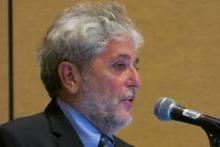SAN FRANCISCO – The greater benefits of laparoscopic gastric banding surgery compared with medical treatment for obese patients were maintained for up to 17 years in a study of data on 1,490 patients.
The 527 obese patients (with or without diabetes) who underwent laparoscopic banding were significantly less likely to die of cardiovascular or noncardiovascular causes and were less likely to develop new cases of type 2 diabetes or cardiovascular disease, compared with the 963 nonsurgery patients, Dr. Antonio E. Pontiroli and his associates reported at the annual scientific sessions of the American Diabetes Association.
Patients underwent laparoscopic banding surgery or were seen for a first visit for medical therapy in 1995-2001, and were followed for 11-17 years, through September 2012.
Three percent of the surgery group and 10% of the nonsurgery group died during follow-up, reported Dr. Pontiroli, chair of internal medicine at Università Degli Studi de Milano and San Paolo Hospital, Milan.
To track morbidity, the investigators analyzed records to see which patients got "exemptions" for specific diseases, an Italian government system in which development of a chronic disease exempts someone from having to pay for exams or treatments for that disease. Any exemption obtained after the first surgical or medical visit was considered a proxy of new disease.
New exemptions were granted to 25% in the surgery group and 42% in the nonsurgery group.
Subset analyses divided 385 surgery patients based on the presence or absence of diabetes, and matched the subgroups separately with 681 nonsurgery patients by sex, age, blood pressure, and body mass index.
In the matched comparisons, 3% of the surgery group and 10% of the nonsurgery group died, and exemptions were granted to 22% of the surgery group and 28% of the nonsurgery group, which were statistically significant differences in the intention-to-treat analyses.
Patients in the surgery group were 66% less likely to die than the nonsurgery patients. Patients without diabetes at the first visit were 67% less likely to die than matched nonsurgery patients, and those with diabetes at the first visit were 56% less likely to die compared with matched nonsurgery patients.
Cardiovascular disease, noncardiovascular disease, or neoplasia were significantly less likely to be the causes of death in the surgery group compared with the nonsurgery group. The surgery group recorded significantly fewer hospitalizations during follow-up (120) than the nonsurgery group (273).
New cases of cardiovascular disease (defined by exemptions) appeared in 13% of the surgery group and 22% of the nonsurgery group. In the matched subgroups, 13% who underwent surgery and 18% in the nonsurgery group developed cardiovascular disease.
Among patients without diabetes at baseline, 5% of 454 in the surgery group and 10% of 724 in the nonsurgery group developed diabetes during follow-up. In the subset analysis of matched patients without diabetes at baseline, 4% of 333 in the surgery group and 9% in the nonsurgery group developed diabetes.
The investigators plan another data assessment in 2017 to confirm these long-term findings. Similar studies are needed for other bariatric surgery techniques, he suggested.
Dr. Pontiroli reported financial associations with Sanofi, Eli Lilly, and other companies.
On Twitter @sherryboschert


